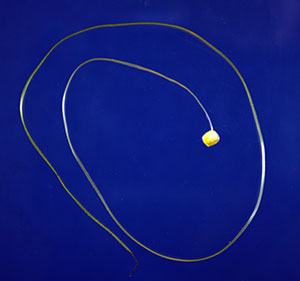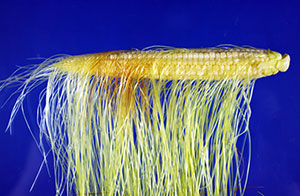Taking an environmentally sensitive approach to pest management
Corn Pollination, the Good, the Bad, and the Ugly
Part 2: The Female RolePublished: July 16, 2012
As I stated in Part 1 of this series, corn is unique among grain crops in that it is monoecious. This means that it possesses flowers that have only male sexual parts and flowers that have only female sexual parts on the same plant.

Figure 1. A single female corn flower composed of ovary, style and stigma. The silk on this flower was 11.5 inches long.
Female flowers are borne on the ear. The female sexual organ in flowers is called the pistil, and the pistil is composed of an ovary, a style, and a stigma (Figure 1). For corn, the ovary will mature to become the kernel, and the ovary wall becomes the outer “skin” of the kernel. Like all grass plants the corn ovary contains only one ovule (a seed is a mature ovule), so when the kernel matures there will be one seed inside each kernel. And, the seed coat fuses tightly to the ovary wall so they cannot be easily separated. The style is highly elongated and called the silk. The stigma is found at the end of the silk and is about one half inch long. The stigma looks like the rest of the silk except that it usually possesses more hairs (trichomes). Although these are technical terms, each of these parts play a role in successful corn fertilization.
Ear development begins early in the life cycle of the corn plant. Ear shoots are microscopic at first and located at stem nodes. Ear shoot growth occurs hidden within the leaf sheaths. If you remove all corn leaves including the sheaths as many as 8 to 10 ear shoots are large enough to be seen without a magnification. Most modern corn hybrids produce a single large ear because the topmost ear shoot dominates all of the other ear shoots.
Between growth stages V5 (5 leaf collars visible) and R1 (silking), primary ear shoot development coincides with tassel development and rapid stem elongation. First, the number of rows of flowers is determined. This number will always be even (e.g. 14, 16, 18) unless a mutation or some odd weather condition had occurred. Second, the number of flowers in each row is determined. Flowers are added to the tip of the ear in response to conditions the plant perceives at this time. Good nitrogen nutrition, high light levels (few weeds), and plentiful sugar production from photosynthesis (good weather) all lead to more flowers per row, and thus, larger ear size.

Figure 2. A corn ear several days after growth stage R1. All husks have been removed.
Silks begin to elongate at about growth stage V12. Silks from flowers near the butt of the ear (closest to the stem) begin to elongate first. Silk from flowers near the tip of the ear begin elongation last. Silk elongation rates also differ among flower positions on the ear, so that silks from flowers near the butt emerge from husks several days before silks from the ear tip. Remember that there is one silk for each flower, so as many as 1000 silks push their way along the ear and within the husks (Figure 2).
The driving force for silk elongation is water pressure. The female flower absorbs water from the cob and the resulting pressure pushes the tip of the silk (stigma) forward. With 1000 silks all elongating at same time the “traffic” often is hectic. The time sequence of silk elongation – from base to tip –, the nearly straight rows of flowers, and small channels on the inside of the husks all give order to the elongation process. And, it works almost flawlessly most of the time. Sometimes silk traffic jams occur and the silks tangle leading to a condition called “silk balling”. When this occurs, some to most of the silks on the ear will not be able to position themselves so that they intercept pollen. Fortunately, this occurrence is rare.

Figure 3. Intact corn ear at growth stage R1./p>
Elongation causes the ends of the silks to emerge outside the husks. One end of each silk is attached to an ovary and one end is visible outside the husks. Growth stage R1 occurs when silks are visible outside of husks (Figure 3). A silk will continue to elongate until at least one pollen grain lands on the silk and a pollen tube enters the silk. If pollination does not occur, silk growth will usually stop after about 10 days, probably because of dehydration. Unusually long silks that hang from the end of an ear is a sign that lack of pollination occurred.
In Part 1 of this series I discussed the role of the male flowers, and in Part 3 I’ll discuss factors that influence the fertilization process.
Sources
Aylor, DE, NP Scultes, and EJ Shields. 2003. An aerobiological framework for assessing cross-pollination in maize. Agricultural and Forrest Meteorology 119:111-129.
Nielsen, RL (Bob). 2000. Silk Development and Emergence in Corn Corny News Network, Purdue Univ. Online at http://www.agry.purdue.edu/ext/corn/news/timeless/silks.html.
Nielsen, RL (Bob). 2000. Scrambled Silks, Anyone? Corny News Network, Purdue Univ. Online at http://www.agry.purdue.edu/ext/corn/news/articles.00/SilkBalling-0718.html.
Subscribe to receive similar articles sent directly to your inbox!
- Weather and Soybean Yields (11/03/15)
- 2013 is Another Drought Year (09/10/13)
- Increased Arrested Development of Corn Kernels May Have Resulted from Cloudy Weather (09/05/13)
REVISED: October 1, 2015